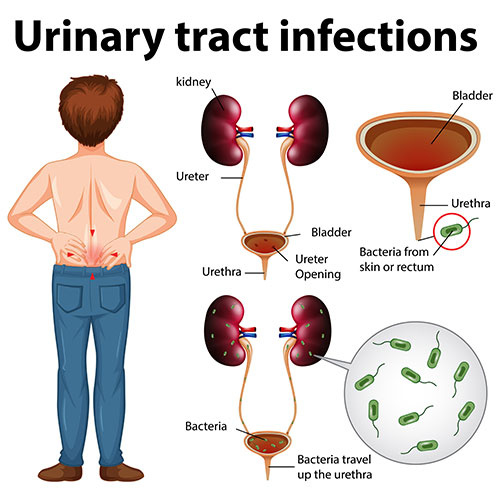Urinary tract infections (UTIs) are a common medical condition affecting millions of people worldwide. They occur when bacteria enter the urinary tract, which includes the kidneys, bladder, ureters, and urethra, and multiply, leading to an infection. UTIs can range from mild to severe and can affect anyone, although they are more common in women.
Typical Symptoms
- Frequent Urination: One of the hallmark symptoms of a UTI is a frequent and urgent need to urinate, even when the bladder is not full. This frequent urge can be accompanied by only small amounts of urine being passed.
- Pain or Burning Sensation: A burning sensation or pain during urination, known as dysuria, is another common symptom of a UTI. This discomfort is caused by irritation and inflammation of the urinary tract lining due to the presence of bacteria.
- Cloudy or Strong-Smelling Urine: Urine infected with bacteria may appear cloudy or have a strong, unpleasant odor. This change in urine color and smell is a result of the body’s immune response to the infection.
- Blood in Urine: Hematuria, or the presence of blood in the urine, can occur with a UTI. The urine may appear pink, red, or cola-colored, indicating bleeding within the urinary tract.
- Pelvic Pain: Some individuals with UTIs may experience pelvic pain, discomfort in the lower abdomen, or pressure in the pelvic region. This discomfort may range from mild to severe and can persist even after urination.
- Fatigue and Malaise: UTIs can cause systemic symptoms such as fatigue, malaise, and a general feeling of unwellness. These symptoms may accompany the localized urinary symptoms and can be indicative of a more severe infection.
- Fever and Chills: In more severe cases of UTIs, particularly when the infection spreads to the kidneys (pyelonephritis), individuals may develop a fever, accompanied by chills and sweats. Fever is a sign that the infection has become more serious and requires prompt medical attention.
Seeking Medical Attention
It’s important to seek medical attention if you experience symptoms of a UTI, especially if they are severe or if you have a history of recurrent UTIs. Untreated UTIs can lead to complications such as kidney damage or bloodstream infections. Healthcare providers typically diagnose UTIs through a combination of symptoms assessment, urine analysis, and sometimes urine culture to identify the specific bacteria causing the infection.
Treatment
Treatment for UTIs usually involves a course of antibiotics prescribed by a healthcare provider. It’s essential to complete the full course of antibiotics as prescribed, even if symptoms improve before the medication is finished, to ensure that the infection is fully eradicated. In addition to antibiotics, drinking plenty of water and urinating frequently can help flush out bacteria from the urinary tract.
Prevention
Preventing UTIs often involves simple lifestyle changes, such as staying hydrated, practicing good hygiene, urinating after sexual intercourse, and avoiding irritating substances like harsh soaps or douches in the genital area. For individuals prone to recurrent UTIs, a healthcare provider may recommend additional preventive measures, such as low-dose antibiotics or cranberry supplements.
In conclusion, urinary tract infections are a common and often uncomfortable condition characterized by symptoms such as frequent urination, pain or burning during urination, cloudy or bloody urine, pelvic pain, and systemic symptoms like fever and fatigue. Seeking prompt medical attention and following prescribed treatment are essential for managing UTIs and preventing complications.





Comments